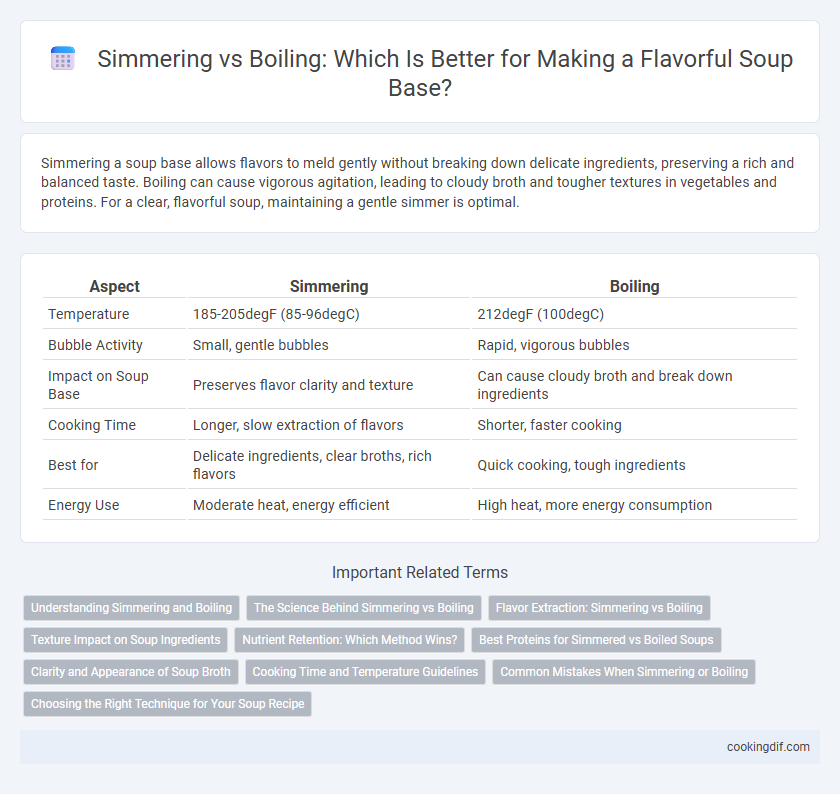Simmering a soup base allows flavors to meld gently without breaking down delicate ingredients, preserving a rich and balanced taste. Boiling can cause vigorous agitation, leading to cloudy broth and tougher textures in vegetables and proteins. For a clear, flavorful soup, maintaining a gentle simmer is optimal.
Table of Comparison
| Aspect | Simmering | Boiling |
|---|---|---|
| Temperature | 185-205degF (85-96degC) | 212degF (100degC) |
| Bubble Activity | Small, gentle bubbles | Rapid, vigorous bubbles |
| Impact on Soup Base | Preserves flavor clarity and texture | Can cause cloudy broth and break down ingredients |
| Cooking Time | Longer, slow extraction of flavors | Shorter, faster cooking |
| Best for | Delicate ingredients, clear broths, rich flavors | Quick cooking, tough ingredients |
| Energy Use | Moderate heat, energy efficient | High heat, more energy consumption |
Understanding Simmering and Boiling
Simmering involves cooking soup at a low temperature just below boiling point, typically between 185degF and 205degF, allowing flavors to meld gently without breaking down delicate ingredients. Boiling occurs at 212degF, causing vigorous bubbles that can rapidly cook but potentially toughen meats and cloud the broth. Understanding the difference ensures optimal texture and clarity in the soup base, preserving nutrient content and enhancing flavor depth.
The Science Behind Simmering vs Boiling
Simmering soup involves maintaining the liquid temperature just below boiling point, around 185-205degF (85-96degC), which allows flavors to meld slowly without agitation that can break down ingredients. Boiling occurs at 212degF (100degC), creating vigorous bubbles that can cause proteins to toughen and fats to separate, leading to a cloudy and less refined soup base. The controlled heat of simmering preserves delicate nutrients and extracts maximum flavor from bones and vegetables, resulting in a rich, clear broth ideal for soups.
Flavor Extraction: Simmering vs Boiling
Simmering allows for gradual extraction of flavors from ingredients, preserving delicate aromatics and producing a richer, more complex soup base. Boiling agitates the liquid vigorously, which can break down proteins and vegetables too quickly, leading to a cloudy broth and less refined taste. For optimal flavor extraction, maintaining a simmer is essential to achieve clarity and depth in soups.
Texture Impact on Soup Ingredients
Simmering soup preserves the delicate texture of ingredients like vegetables and meat, preventing them from becoming mushy or tough. Boiling, with its rapid, vigorous bubbles, can break down cell walls faster, leading to softer, sometimes overcooked textures. Maintaining a gentle simmer is ideal for balancing flavor extraction while protecting the integrity of key soup components.
Nutrient Retention: Which Method Wins?
Simmering preserves more nutrients in soup bases compared to boiling, as it involves cooking at lower temperatures that minimize vitamin and mineral loss. Boiling causes vigorous agitation and higher heat, leading to the breakdown of sensitive compounds like vitamin C and B vitamins. Therefore, simmering is the preferable method for maintaining the nutritional quality of soups.
Best Proteins for Simmered vs Boiled Soups
Simmering soup bases preserves delicate proteins like fish and tofu, preventing them from becoming tough or rubbery, while boiling is better suited for heartier proteins such as beef, chicken, and tougher cuts that require extended cooking to break down collagen and develop flavor. Proteins in simmered soups maintain a tender texture and retain more nutrients compared to those in vigorously boiled soups, where rapid bubbles can toughen meat fibers. Selecting the right cooking method depends on the protein's texture and desired soup consistency, optimizing flavor and mouthfeel in each dish.
Clarity and Appearance of Soup Broth
Simmering the soup base helps maintain clarity by gently cooking ingredients, preventing cloudiness caused by vigorous boiling. Boiling agitates particles and breaks down fats rapidly, resulting in a murkier broth with reduced visual appeal. Optimal soup appearance relies on simmering to extract flavors while preserving a clear, vibrant broth.
Cooking Time and Temperature Guidelines
Simmering soup bases usually occurs at temperatures between 185degF to 205degF, allowing flavors to meld over extended cooking times of 1 to 3 hours without breaking down ingredients. Boiling, at 212degF, accelerates cooking processes but can toughen proteins and cause cloudy broths if maintained too long. Maintaining a gentle simmer preserves clarity and complexity in soup bases while reducing evaporation and overcooking risks.
Common Mistakes When Simmering or Boiling
Simmering soup at too high a temperature causes rapid boiling, which can break down ingredients and result in cloudy broth. Boiling for extended periods often leads to over-reduced liquid and a loss of flavor complexity in the soup base. Many cooks mistakenly confuse a gentle simmer with boiling, ignoring the need for low, steady heat to preserve texture and clear broth quality.
Choosing the Right Technique for Your Soup Recipe
Simmering a soup base preserves delicate flavors and prevents ingredients from breaking apart, making it ideal for broths and slow-cooked recipes. Boiling quickly cooks ingredients and extracts robust flavors but can toughen proteins and cause cloudy broth. Selecting simmering or boiling depends on the desired texture, flavor clarity, and cooking time for your specific soup recipe.
Simmering vs Boiling for soup base Infographic

 cookingdif.com
cookingdif.com